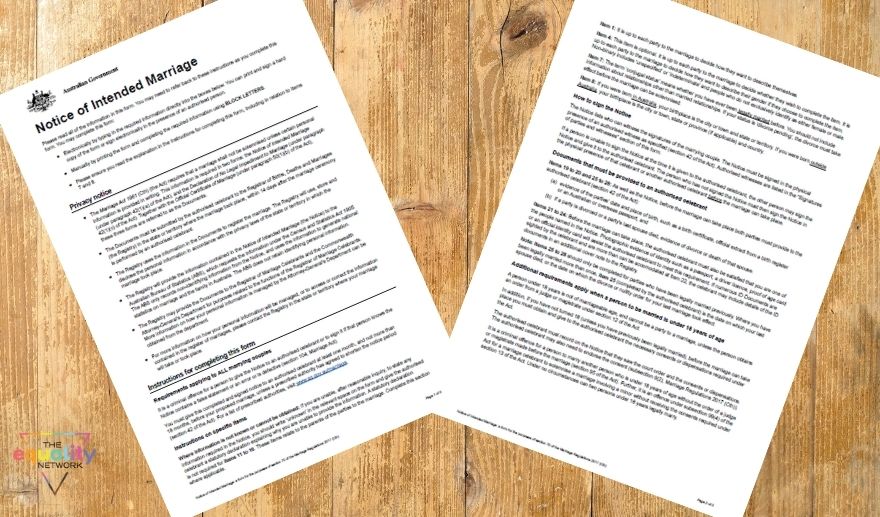Changes to the Notice of Intended Marriage (NOIM) From 1st September 2021

It’s taken a long time, but the Australian Attorney-General’s Department (AGD) has finally released a revised Notice of Intended Marriage (NOIM). The previous NOIM was clunky and tried to cover data collected before the marriage and after the marriage, with little space for data entry. It became outdated and clumsy.
Download the new NOIM (effective from 1 September 2021) in PDF or MS Word format.
Of course, there are lots of stakeholders impacted by these changes, including couples seeking to get married, state and territory Registries of Births, Deaths and Marriages (BDMs), the Australian Bureau of Statistics (ABS), the Department of Home Affairs, the National Archives of Australia, celebrants and members of the public.
The changes on the revised NOIM take effect from 1 September 2021. From that date, all couples wishing to get married in Australia and authorised celebrants must use the revised NOIM.
NOIMs that were signed in front of an authorised witness and submitted to a registered marriage celebrant before 1 September 2021 will remain valid for a period of 18 months from the date the couple lodged the NOIM with the celebran

The main changes in the revised NOIM are:
1. Sex / gender is optional
The AGD has changed the name of item 4 from the outdated term ‘Sex’ to ‘Gender’. These terms are often used interchangeably in the broader community but should not be confused with ‘Gender Identity’ which is different from ‘Gender’. One of the best things about the new NOIM is that ‘Gender’ is now an optional field.
Given that, since December 2017, marriage in Australia has been between ‘two people’, it seems anachronistic that the NOIM continues to ask people wanting to get married to jot down their ‘gender’. It’s irrelevant. The fact that ‘gender’ data are still collected is driven by the requirement of the ABS to continue to collect data on out-dated data sets.
The problem with giving only the options of ‘female’ or ‘male’ or ‘non-binary’ as people’s ‘gender’ is that there are people wanting to get married who don’t identify as any of those three categories.
But at least the previous, highly offensive ‘sex’ option ‘X’ on the NOIM has been renamed ‘non-binary’, consistent with the Australian Government Guidelines on the Recognition of Sex and Gender. Eventually, it’s hoped that those guidelines and the NOIM will catch up with reality and be truly inclusive and representative of how people in the community actually identify.
Remember, neither party wanting to get married has to fill in their ’gender’. It’s optional.
2. Is your divorce pending?
At item 7, a new option for ‘conjugal status’ is now included – ‘divorce pending’. This option is already used by some BDMs where a party’s divorce has not been finalised at the time the NOIM is lodged.
This change will enable the NOIM to reflect the actual and current situations of people filling it in. And, when the divorce comes through for a person who has written ‘divorce pending’ on the NOIM, they can simply update it. As with ‘gender’ in point 1. above, whilst the AGD continues to try to put everyone into a certain box, not everyone fits neatly into a ‘never validly married’ or ‘divorced’ or ‘widowed’ box.
3. Irrelevant question deleted
One of the awful things about previous NOIMs is that they collected data that was simply never required under the Marriage Act 1961. One such example of is the former question ‘If a party born outside Australia, total period of residence in Australia’. Thankfully, this question, sought by the ABS, is no longer included in the revised NOIM.
4. Are you both related?
One question that’s very relevant to people getting married is 10 – Are the parties related? It’s always been a question on the NOIM. It is legal in Australia for first cousins to marry or an uncle to marry their nephew or niece, or an aunt to marry their nephew or niece.
But it’s illegal in Australia for people already married to each other to marry each other again without first getting divorced, or for a parent to marry their birth daughter or son or adopted daughter or son, or for someone to marry their birth grandchild or adopted grandchild or for someone to marry their sibling or half-sibling.

5. Parents’ names – improved equality
There’s been another part of the previous NOIM that’s caused distress to lots of couples. It required the names of both parents of both people wanting to get married, to be recorded on the NOIM. Incredibly, it simply asked for the father’s name in full, for each party. Then it asked for the mother’s ‘maiden name’ in full as well as her current name.
Wow! This is 2021 and the AGD is still using outdated terms such as ‘maiden name’! And the previous NOIM asked for more information about the mother of each party than it did about the father of each party.
That has now changed. The revised NOIM asks couples for ‘Parent 1’s full current name’ and ‘If applicable: Parent 2’s full current name’ and added new items ‘Parent 1’s full birth name’ and ‘If applicable: Parent 2’s full birth name’.
Whilst the AGD states ‘this approach is inclusive of same-sex parents, parents who do not identify as male or female, and parties who only have one legal parent’, it is a concern that it may not include LGBTIQA+ people who have had children via IVF, adoption or surrogacy.
And, of course, people from the LGBTIQA+ community who wish to get married are not necessarily ‘same sex’ as the AGD describe them. The language used by the AGD in their own Fact Sheet remains non-inclusive.
6. More irrelevant questions deleted
In the revised NOIM, the AGD has removed several old items that caused some upset amongst couples: for example,
- the number of times each party had previously been married,
- the year of each previous marriage ceremony,
- the number of children of the previous marriage or marriages born alive, and the year of birth of each of those children.
None of this information, although mandatory to be collected on the NOIM was ever transferred to, or recorded on, the Official Certificate of Marriage. And, most importantly, none of this information was used by the ABS.
Recently, the ABS advised that there are no current statistical requirements regarding the collection of this information and so, it has now been deleted from the revised NOIM.
7. Don’t forget you need proof of ID!
The questions a celebrant must answer to confirm that they have satisfied themselves about the parties’ identities have changed.
Celebrants are still encouraged to request photographic ID documents to confirm a party’s identity. There’s a wide scope of documents that can be used for that – eg passport, driver’s licence, proof of age card, ImmiCard, Keypass identity card. Rather than listing all the possible options, the revised NOIM now enables celebrants to indicate the type of document that was sighted, record the number on the document (if any) and where the document was issued (if applicable).
8. Easier transfer of NOIM
Additional information is now collected where the NOIM is transferred from one celebrant to another. The new information collected includes the name of the new celebrant and the date of transfer, as well as an endorsement by the new celebrant that the NOIM was transferred for appropriate reasons. It is not clear what the AGD regards as ‘appropriate reasons’.







Responses